Dinosaurs inhabited Earth for around one hundred and seventy million years, and in that vast period of time, many different types of dinosaurs evolved and became extinct.
(Human beings have only existed for three hundred thousand years; a tiny fraction of the time that dinosaurs existed.)
In order to understand the relationships between different types of dinosaurs, paleontologists organize individual dinosaur species into groups of related species.
For example, Tyrannosaurus rex was part of a family of dinosaurs known as Tyrannosauridae, which itself was part of an even larger group of dinosaurs: Saurischia, which contained both predatory and herbivorous species.
On this page, we list the major dinosaur groups, and provide examples of dinosaurs of each type.
(If you want to see a list of individual dinosaurs rather than types of dinosaurs, visit this page: List of Dinosaurs.)
Page Index
Related Pages On Active Wild
You can see dinosaurs from specific periods of the Mesozoic Era on the following pages:
You can find in-depth information on each of the three periods of the Mesozoic Era on the following pages:
Types of Dinosaurs: Introduction
Types of dinosaurs include major groups such as saurischians and ornithischians, which are divided into smaller groups such as theropods and sauropods, which themselves are divided into smaller groups, such as the families Tyrannosauridae, Spinosauridae and Hadrosauridae.
All of these dinosaur groups–and more–are covered on this page.
Dinosaurs themselves form the group Dinosauria. Dinosauria is a group within the class Reptilia, which is a scientific way of saying that dinosaurs are reptiles!
- You can find out more about reptiles on this page: Reptiles - The Ultimate Guide
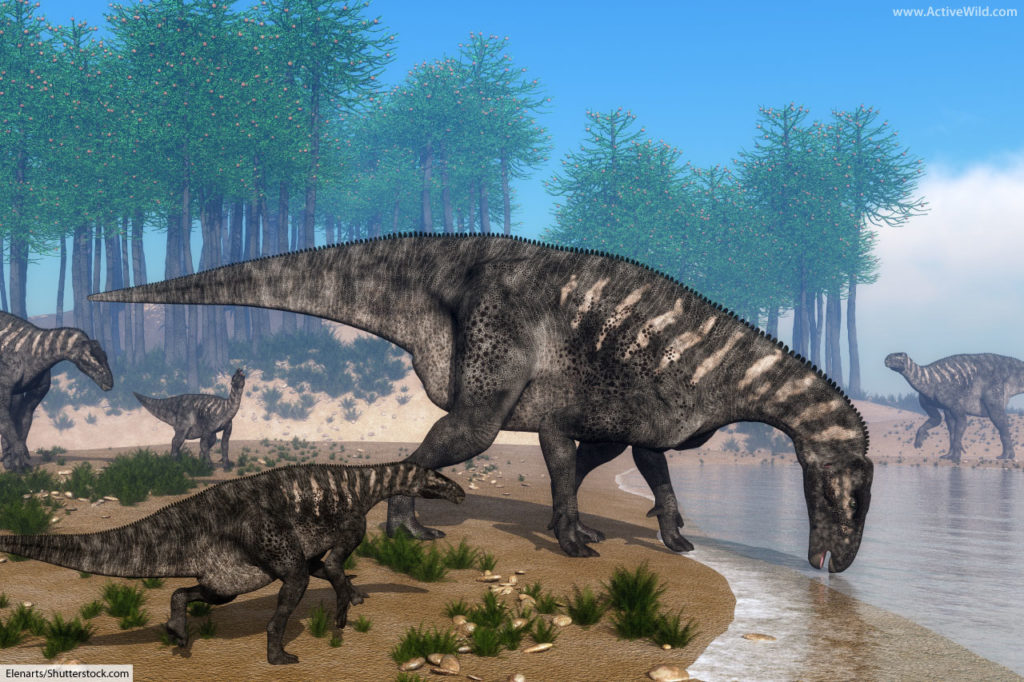
Dinosaurs, like all living things, are grouped together depending on how closely they’re related to each other. The process of grouping living things is known as classification.
Related species tend to share physical characteristics; all tyrannosaurid dinosaurs, for example, were large, bipedal dinosaurs with heavy skulls.
Paleontologists classify dinosaurs by studying their fossilized remains, finding characteristics that identify the dinosaur as belonging to a certain group.
Reptiles, mammals, insects, and all other animals belong to the group Animalia: the animal kingdom.
- You can learn more about the different groups of living things on this page: Animal Classification.
- You can find out more about the animal kingdom on this page: Animals
Dinosaur Names
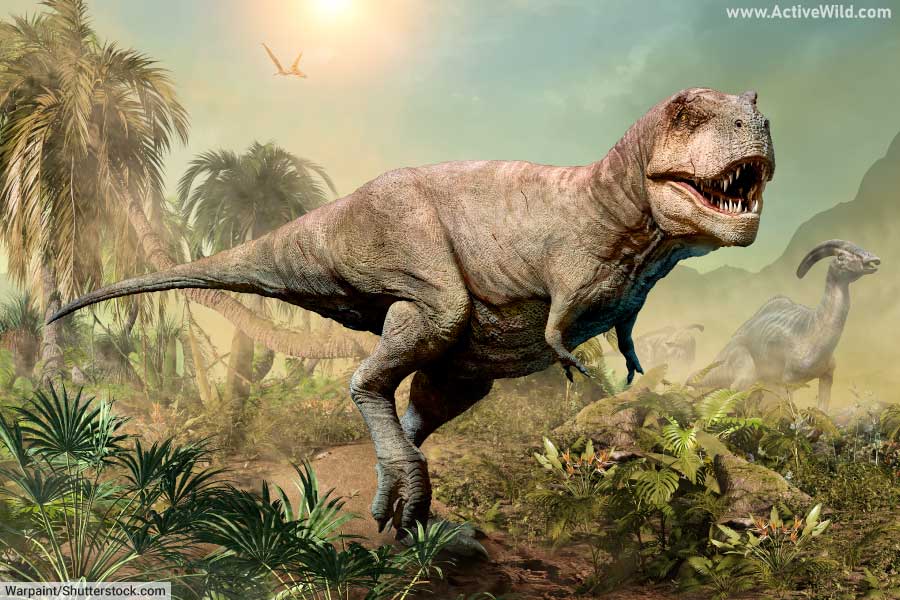
Most dinosaurs are known by their genus, rather than by their species name. For example, Iguanodon is a genus, rather than an individual species. (An example of an Iguanodon species is Iguanodon bernissartensis.)
A genus is a group of closely-related species. For example, the genus Homo contains not only Homo sapiens (humans), but also several other species, such as neanderthals (Homo neanderthalensis).
In fact, most people have only heard of one species of dinosaur – Tyrannosaurus Rex, which is a species of Tyrannosaurus. All of the other famous dinosaur names, such as Spinosaurus, Allosaurus and Velociraptor, are genera.
Note that the scientific name of a species has two parts, the first part being the genus to which the species belongs. Tyrannosaurus rex is a species of genus Tyrannosaurus. It is traditional to write both the genus and species name in italics, with the genus being capitalized.
Often, the first part of an animal's scientific name (the genus) is shortened to just its initial. This is why Tyrannosaurus rex is often shortened to T. rex.
Science doesn't stand still: as we discover more about dinosaurs, the way in which different types of dinosaurs are classified is likely to change.
On this page we’ll learn about the different types of dinosaurs, and how they are currently grouped.
The Two Main Types Of Dinosaur
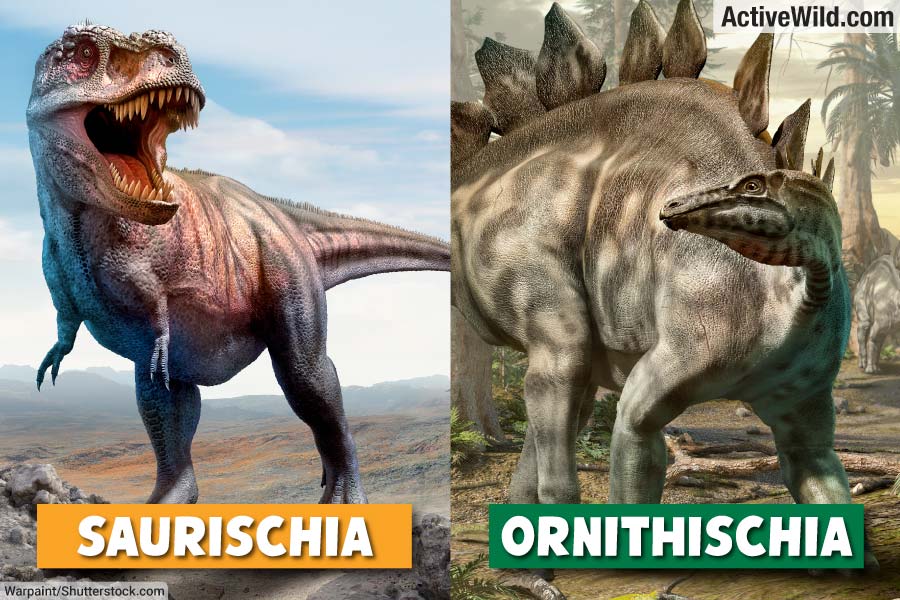
There are two main types of dinosaur: saurischia and ornithischia.
It was English paleontologist Harry Seeley (see Wikipedia) who first noticed that were two main types of dinosaur: those whose hips were lizard-like in structure, and those whose hips bird-like in structure.
Seeley called the lizard-hipped dinosaurs ‘saurischians’, which comes from the Greek for ‘lizard hip joint’.
Those with bird-like hips he named ‘ornithischians’, which comes from the Greek for ‘bird hip joint’.
Saurischians Vs Ornithischians
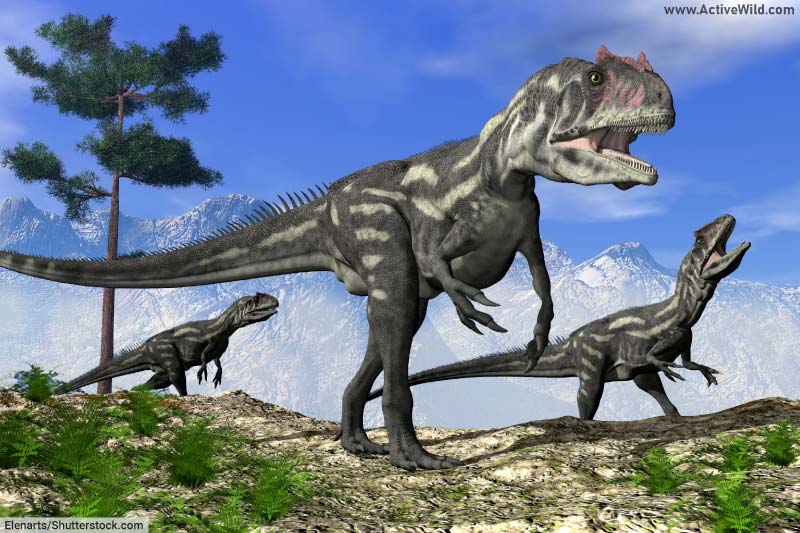
All of the carnivorous (meat-eating) dinosaurs were saurischians, as were many herbivorous (plant-eating) dinosaurs.
In general, all ornithischians were herbivores. However, there may have been a few ornithischians that were omnivorous or even carnivorous.
Fossil evidence suggests that ornithischians lived in herds.
- Saurischians = either carnivores or herbivores
- Ornithischians = nearly all herbivores (possibly some omnivores / partial carnivores). Probably lived in herds.
Confusingly, the ornithischian, or bird-hipped, dinosaurs were NOT the ancestors of birds. Birds evolved from a group of saurischian (lizard-hipped) dinosaurs called theropods.
Types Of Dinosaurs: Saurischians
In this section, we’re going to look at some well-known types of saurischian dinosaurs. The two main types of saurischian dinosaurs are theropods and sauropods.
Theropods

Theropod dinosaurs were bipedal meat eaters. (‘Bipedal’ means that they walked on two legs)
Tyrannosaurus, Spinosaurus, Velociraptor: all of these famous predatory dinosaurs were theropods. The word ‘theropod’ comes from the Greek for ‘wild beast foot’.
Theropods first appeared in the late Triassic period, and were present all the way up to the Cretaceous–Paleogene extinction event, which brought the reign of the dinosaurs to an end.
The Triassic Period was the first of the three periods in which dinosaurs existed. It was followed by the Jurassic Period, which was then followed by the Cretaceous Period.
You can find out more about these periods on this page: Dinosaur Periods
Theropods Become Birds
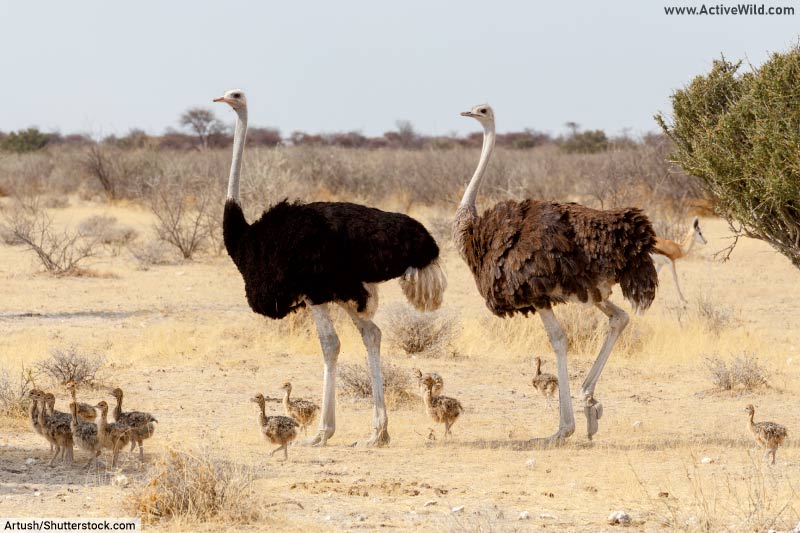
The Cretaceous–Paleogene extinction event wasn’t actually the end for the theropods. One group of theropods had already branched off and evolved into birds.
Today, most scientists are agreed that all birds are dinosaurs. Therefore, you only have to look out of your window to see that dinosaurs are very much alive today!
Types of Theropod Dinosaurs
Coelurosaurs
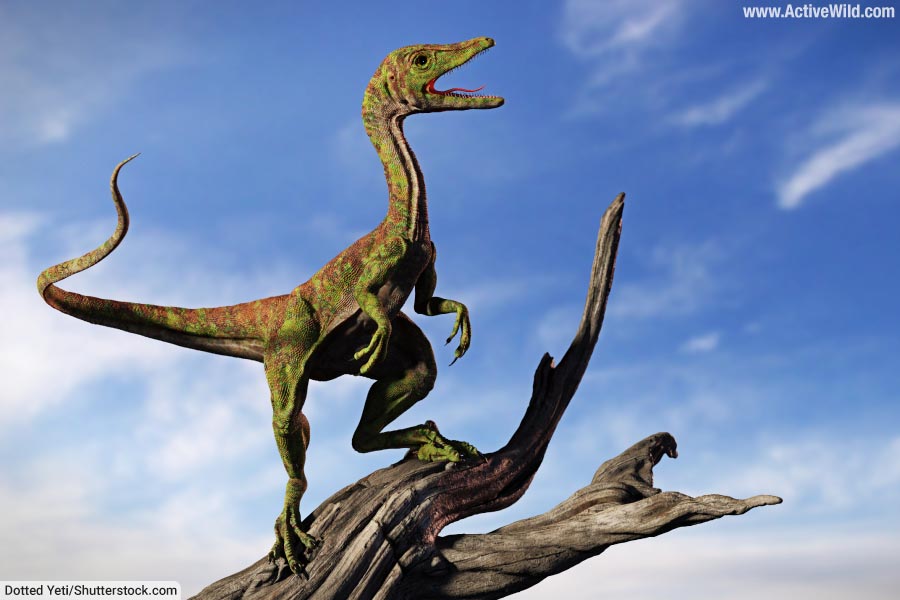
Coelurosaur means ‘hollow tailed lizard’. Coelurosauria is a large group of dinosaurs that contains theropods that were more like birds than Carnosaurians (a group of dinosaurs which we’ll meet further down the page). The Tyrannosaurids, including T Rex, were coelurosaurs.
Maniraptora
Maniraptora is a branch of bird-like dinosaurs. They first appeared in the Jurassic Period, and are the ancestors of modern-day birds. This group of dinosaurs includes the Dromaeosauridae (raptor) family.
Family: Dromaeosauridae (Raptors)
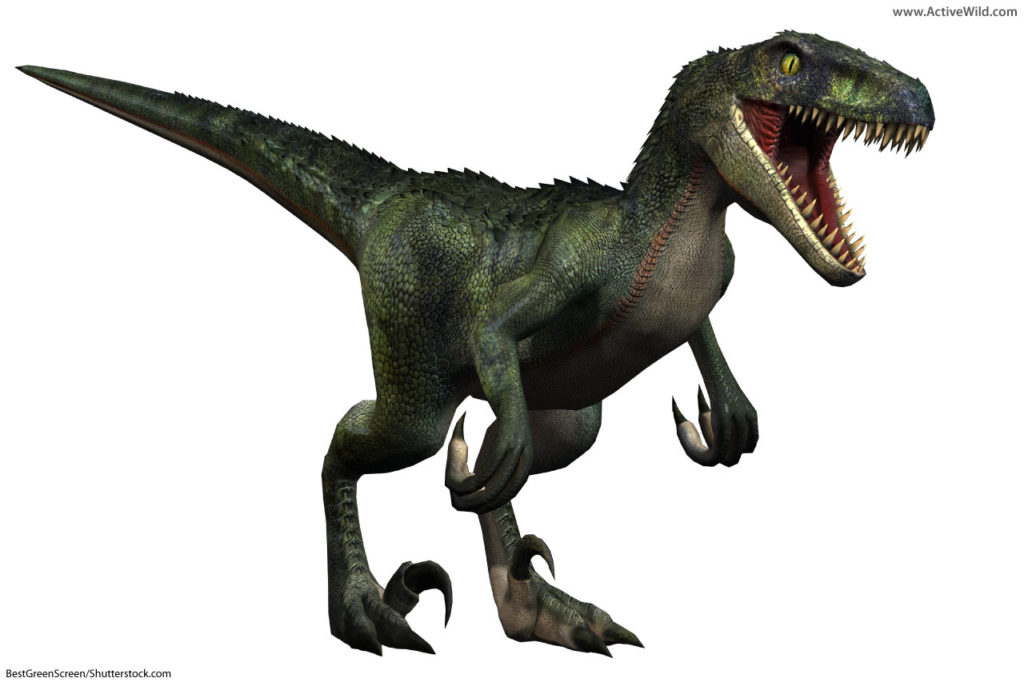
Members of the dinosaur family Dromaeosauridae are sometimes known as "raptors". These feathered dinosaurs appeared in the mid-Jurassic period. They ranged from small, bird-like species to larger, more robust predators.
Example Dromaeosaurids
- Velociraptor: Perhaps the most famous dromaeosaurid, Velociraptor lived during the Late Cretaceous period. It was smaller than often depicted in popular media, roughly the size of a turkey, and was covered in feathers.
- Deinonychus: This larger and more robust dromaeosaurid lived during the Early Cretaceous period. Deinonychus is notable for its powerful legs and large, sickle-shaped claws, which it likely used for hunting and climbing.
- Microraptor: A small, four-winged dromaeosaurid that lived during the Early Cretaceous. Microraptor is unique for its long feathers on both its arms and legs, suggesting it could glide or possibly even fly.
- Utahraptor: One of the largest known dromaeosaurids, Utahraptor lived during the Early Cretaceous period. It was significantly larger than Velociraptor, with some estimates suggesting it could grow up to 7 meters in length.
- Dakotaraptor: A relatively recent discovery, Dakotaraptor lived during the Late Cretaceous period. It was large for a dromaeosaurid and had a robust build, with a particularly large sickle claw on each foot.
Family: Abelisauridae
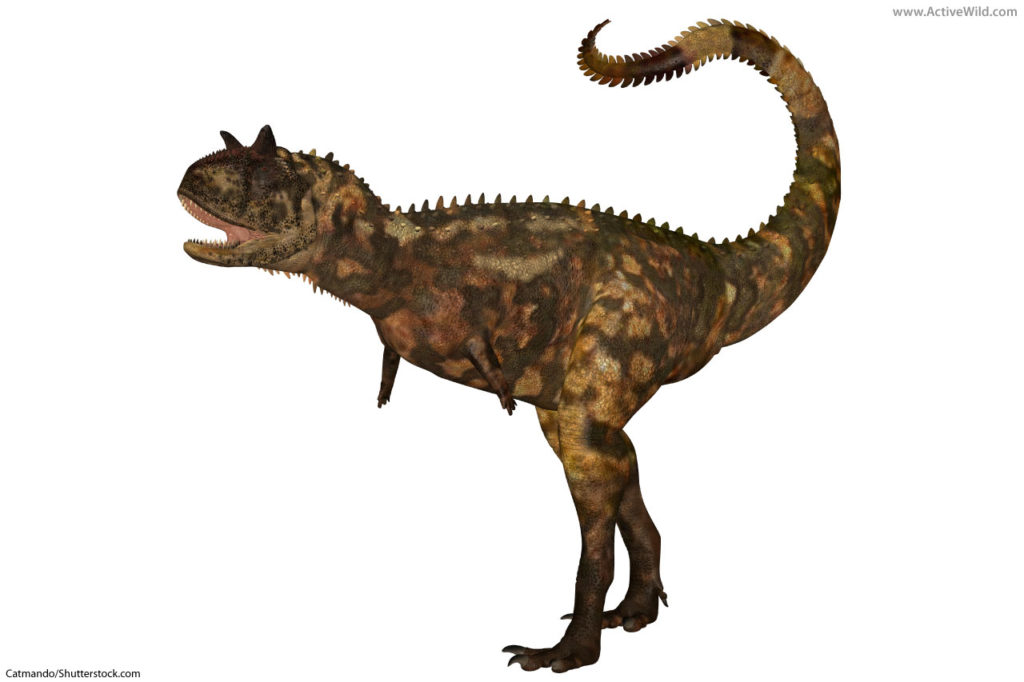
Abelisauridae is a family of theropod dinosaurs that lived in Africa, South America and Asia during the Cretaceous period.
This type of dinosaur typically had powerful hind legs and extremely short forelimbs. Their skulls were short in length, but tall, and often had grooves or projections (one of the most famous Abelisaurid dinosaurs, Carnotaurus, had thick, bony horns.)
Example Abelisaurids
- Abelisaurus: The namesake of the group, Abelisaurus lived during the Late Cretaceous period in what is now South America. It was a large theropod, though only its skull has been extensively studied.
- Carnotaurus: Perhaps the most famous abelisaurid, Carnotaurus is known for its distinctive horns above its eyes and its extremely reduced forelimbs. It lived in South America during the Late Cretaceous period.
- Majungasaurus: This abelisaurid from Madagascar lived during the Late Cretaceous period. It is known for its unique, domed skull and short, deep snout.
- Rajasaurus: Living in what is now India during the Late Cretaceous, Rajasaurus had a distinctive single horn on its forehead. It was a medium-sized abelisaurid.
- Ekrixinatosaurus: Another South American abelisaurid from the Late Cretaceous period, Ekrixinatosaurus was a large predator, though much of its life history remains a mystery due to limited fossil findings.
Family: Tyrannosauridae
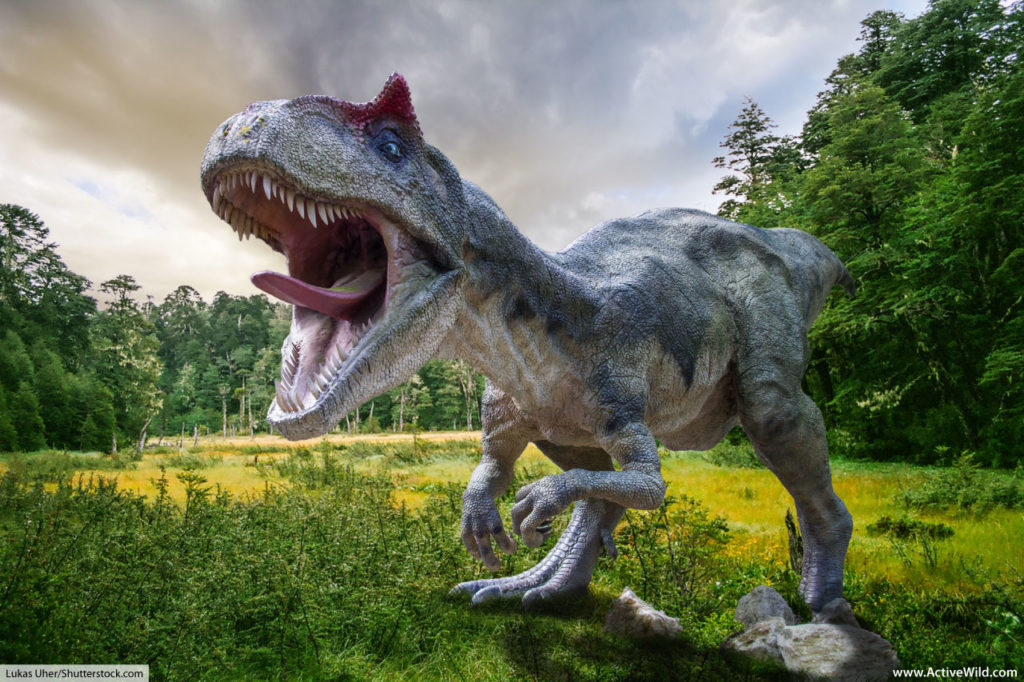
Named after Tyrannosaurus (which means ‘tyrant lizard’), Tyrannosauridae is a family of bipedal, meat-eating theropod dinosaurs. Tyrannosaurids are known for their huge skulls, powerful jaws, and short arms.
Perhaps the most famous dinosaur of all, Tyrannosaurus Rex, was a member of the Tyrannosauridae family.
Example Tyrannosaurids
- Tyrannosaurus rex: The most famous tyrannosaurid, T. rex lived during the Late Cretaceous period in what is now North America. It was one of the largest land carnivores of all time, reaching lengths of up to 40 feet.
- Albertosaurus: A smaller relative of T. rex, Albertosaurus lived in the Late Cretaceous period in North America. It was more lightly built compared to T. rex, with longer, more slender limbs suggesting greater agility.
- Gorgosaurus: This tyrannosaurid was similar in size and appearance to Albertosaurus but lived slightly earlier during the Late Cretaceous. Gorgosaurus was also a North American dinosaur, known for its powerful build.
- Daspletosaurus: Another tyrannosaurid from North America, Daspletosaurus lived during the Late Cretaceous period. It was known for its robust skull and teeth, which were designed for crushing bone.
- Tarbosaurus: Closely related to T. rex, Tarbosaurus lived in Asia during the Late Cretaceous period. It shared many characteristics with T. rex, including a massive skull and powerful jaws, but had slightly different proportions and skull features.
Family: Spinosauridae
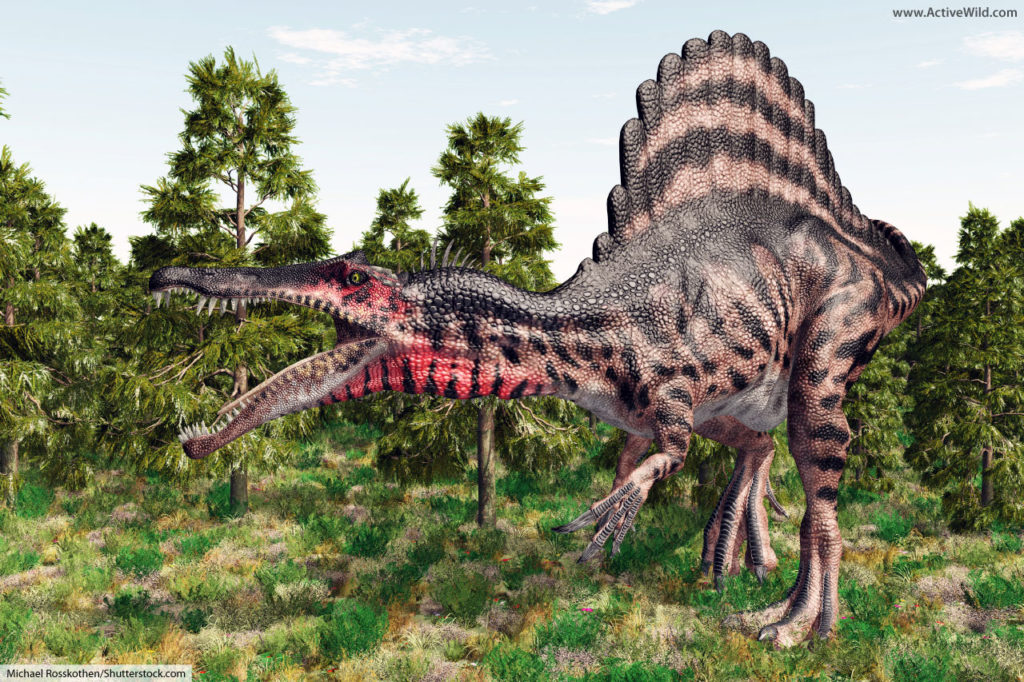
The spinosaurids were another family of large, bipedal, meat-eating dinosaurs. Spinosaurids had long, thin, crocodile-like skulls and specialized teeth adapted for catching fish. Some members of this family, such as Spinosaurus and Baryonyx, were specialized fish-eaters.
Spinosaurus itself had a large sail on its back. This was held up by spine-like bones, from which it got its name (Spinosaurus means ‘spine lizard’). The Spinosauridae family was named after Spinosaurus, but not all members of the family have a similar sail.
Example Spinosaurids
- Spinosaurus: The most famous spinosaurid, Spinosaurus lived in what is now North Africa during the Late Cretaceous period. It is distinguished by its long, narrow skull and a sail-like structure on its back, formed by elongated spinal vertebrae. Spinosaurus is thought to have been semi-aquatic, hunting both in water and on land.
- Baryonyx: This spinosaurid lived during the Early Cretaceous period in what is now Europe. Baryonyx had a long, narrow snout filled with conical teeth and a large claw on its first finger, which it may have used for fishing. Its build suggests it was well-adapted for a diet that included fish and other small prey.
- Irritator: Irritator was a spinosaurid theropod dinosaur that lived during the Early Cretaceous period, approximately 110 million years ago, in what is now Brazil. Its name, derived from the irritation felt by the paleontologists who discovered that the fossil had been artificially modified by fossil poachers, reflects a unique aspect of its discovery. Irritator was a medium-sized spinosaurid, estimated to be about 8 meters (26 feet) in length. It possessed a long, narrow skull similar to that of a crocodile, adapted for a diet that likely included fish.
- Suchomimus: Living in Africa during the Early Cretaceous period, Suchomimus also featured a crocodile-like snout and conical teeth, ideal for catching fish. It had a large claw on its hand and a ridge of elongated spines along its back, though not as pronounced as the sail of Spinosaurus.
Carnosauria
Carnosauria is a group of theropods that includes the families Allosauridae and Carcharodontosauridae.
Family: Allosauridae
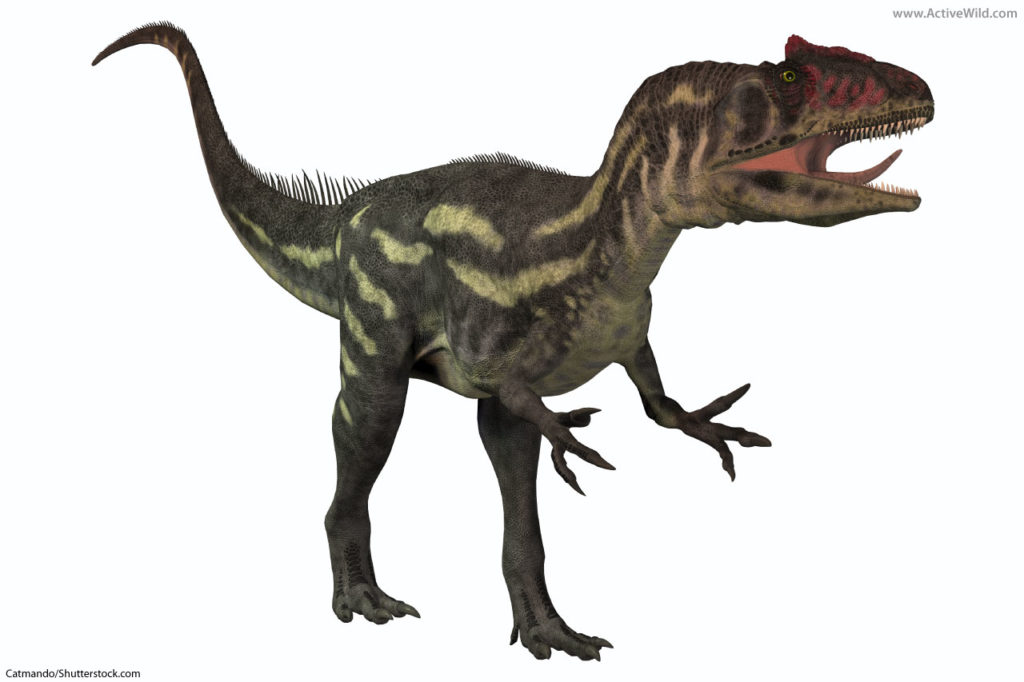
Allosauridae is a family of predatory dinosaurs that lived in the late Jurassic and early Cretaceous periods. These large theropod dinosaurs were apex predators in their ecosystems during the Late Jurassic to Early Cretaceous periods.
Example Allosaurids
- Allosaurus: The most famous allosaurid, Allosaurus lived during the Late Jurassic period. It was a large predator, characterized by its powerful jaws, sharp teeth, and large claws. Allosaurus was one of the dominant predators in North America and possibly other parts of the world.
- Saurophaganax: This dinosaur, which might represent a large species of Allosaurus, lived in North America during the Late Jurassic. Saurophaganax was one of the largest allosaurids, known for its size and strength.
- Sinraptor: Living during the Late Jurassic in what is now China, Sinraptor was a smaller allosaurid compared to Allosaurus and Saurophaganax. It was a swift and agile predator, adapted to hunting the dinosaurs that shared its environment.
Family: Carcharodontosauridae

Carcharodontosauridae is a family of dinosaurs that includes some of the largest land carnivores that ever lived. The name is derived from the Greek for ‘shark-toothed lizards’.
Carcharodontosaurids had massive skulls equipped with sharp, serrated teeth, suited for hunting and consuming large prey. These powerful dinosaurs were among the top predators in their respective ecosystems.
Example Carcharodontosaurids
- Carcharodontosaurus: The namesake of this group, Carcharodontosaurus lived in North Africa during the Late Cretaceous period. It was one of the largest known carnivorous dinosaurs, comparable in size to Tyrannosaurus rex. Its name means "shark-toothed lizard," reflecting its large, serrated teeth.
- Giganotosaurus: This massive predator lived in what is now Argentina during the Late Cretaceous period. Giganotosaurus is one of the largest theropod dinosaurs ever discovered, potentially even larger than T. rex. It had a long skull and powerful jaws filled with sharp teeth.
- Mapusaurus: Also from the Late Cretaceous of Argentina, Mapusaurus was similar in size to Giganotosaurus. It's known from a bonebed containing multiple individuals, suggesting that Mapusaurus may have lived and possibly hunted in groups.
- Tyrannotitan: A large carcharodontosaurid theropod dinosaur that lived in Argentina during the Early Cretaceous period, about 112 million years ago. Tyrannotitan stood out for its large size, potentially reaching lengths of around 12 meters (39 feet).
Sauropods
The sauropods were a group of saurischian dinosaurs. Many sauropods grew to incredible sizes, and the group contains the biggest land animals ever to walk the earth.
Giant dinosaurs such as Apatosaurus, Diplodocus, and Titanosaurus were all sauropods.
A typical sauropod had a large barrel-shaped body, a long neck, a small head, and a long, powerful tail. It stood on four, tree-trunk like, legs.
Family: Diplodocidae
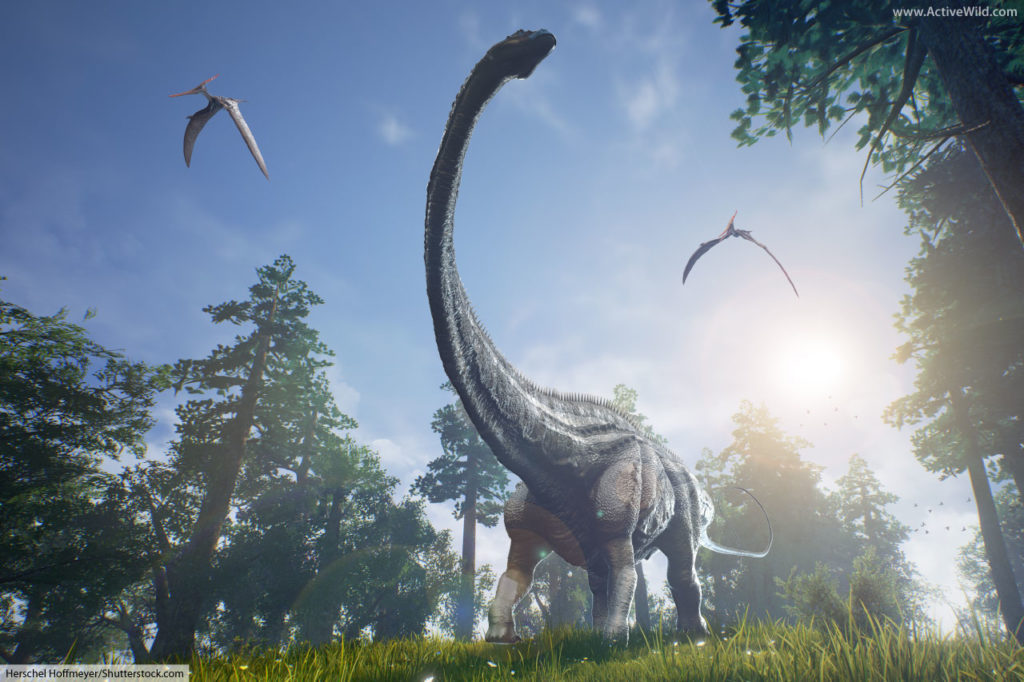
Diplodocidae was a family of sauropod dinosaurs. Members of this family typically had very long bodies and whip-like tails. Their legs were relatively short, and they were not as tall as other sauropods.
Example Diplodocids
- Diplodocus: Perhaps the most famous of the group, Diplodocus lived during the Late Jurassic period in what is now North America. It was characterized by an extremely long tail, long neck, and a relatively small head. Diplodocus could reach lengths of up to 27 meters (88 feet).
- Apatosaurus (formerly known as Brontosaurus): Also from the Late Jurassic of North America, Apatosaurus was similar in size to Diplodocus but had a sturdier build, with a more robust neck and legs. Its name means "deceptive lizard."
- Brachytrachelopan: A unique member of the diplodocid family, Brachytrachelopan lived in South America during the Late Jurassic. It was distinguished by its unusually short neck, which was a rare trait among the typically long-necked sauropods.
- Brontosaurus, once controversially classified and later reinstated as a distinct genus of sauropod dinosaurs, lived during the Late Jurassic period, about 155 to 150 million years ago. Known for its immense size, long neck, and whip-like tail, Brontosaurus was a herbivorous dinosaur that roamed the floodplains of what is now North America.
- Supersaurus: One of the largest dinosaurs ever discovered, Supersaurus lived during the Late Jurassic period. It was notable for its enormous size, with some estimates suggesting a length of over 30 meters (98 feet), making it one of the longest sauropods.
Titanosauria
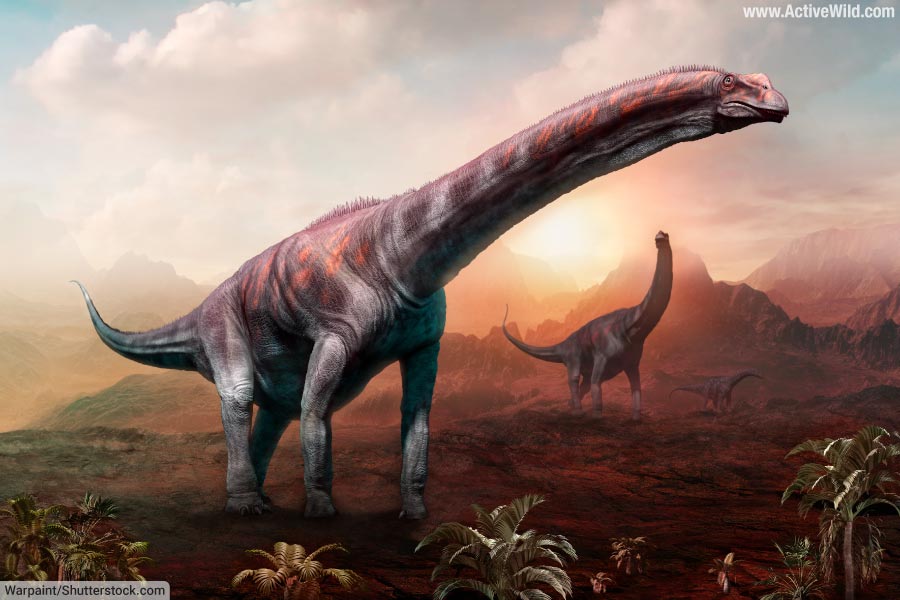
Titanosaurs were a branch of sauropod dinosaurs that appeared in the early Cretaceous and lived right up to the end of the Mesozoic era. They were typically sauropod in general shape, and had small heads, large nostrils, and bony crests.
The group includes Argentinosaurus, a genus which, although only known from a small selection of bones, was possibly the largest ever land animal ever to have lived.
Example Titanosaurs
- Argentinosaurus: One of the largest known land animals of all time, Argentinosaurus lived during the Late Cretaceous period in what is now Argentina. It's estimated to have reached lengths of up to 30 meters (98 feet) and possibly weighed as much as 100 tons.
- Patagotitan: Discovered in Argentina, Patagotitan is another colossal member of the titanosaurs, living during the Late Cretaceous. It was similar in size to Argentinosaurus, with some estimates suggesting a length of around 37 meters (121 feet).
- Saltasaurus: Known for being one of the first sauropods discovered with bony armor, Saltasaurus was a relatively smaller titanosaur that lived during the Late Cretaceous in South America. It was about 12.2 to 12.8 meters (40 to 42 feet) in length.
- Dreadnoughtus: One of the most complete titanosaurs ever found, Dreadnoughtus lived during the Late Cretaceous in what is now South America. Estimates of its size suggest it was about 26 meters (85 feet) long and may have weighed around 59 tons.
Types Of Dinosaurs: Ornithischians
Ornithischian (bird-hipped) dinosaurs were one of the two main types of dinosaurs (the other being the lizard-hipped Saurischians, which we've covered further up the page).
Many Ornithischians had beaks and jaws that were adapted for cutting and chewing plants
Some of the best-known types of Ornithischian dinosaurs are listed below.
Thyreophora (Armored Dinosaurs)
Thyreophora was a branch of ornithischian dinosaurs. Thyreophora means ‘shield bearers’. Another name given to this group is ‘armored dinosaurs’.
Thyreophorans were heavily armored with thick skin and rows of plates running along their bodies. Many were further protected by spikes and tail clubs.
Two well-known groups of Thyreophorans were Stegosauria and Ankylosauria.
Stegosauria
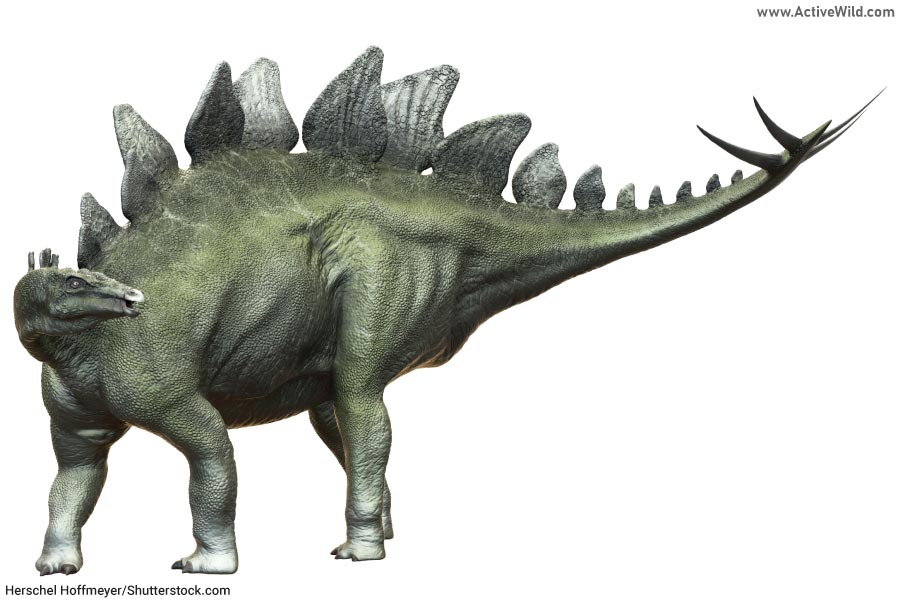
Stegosaurian dinosaurs were a group of herbivorous, armored dinosaurs known for their distinctive plates and spikes along their backs and tails.
Stegosaurus is the best-known Stegosaurian, but several other genera have been discovered. Stegosaurus belonged to the family Stegosauridae. Another Stegosaurian family is Huayangosauridae.
Example Stegosaurians
- Stegosaurus: The most famous stegosaurian, Stegosaurus lived during the Late Jurassic period in what is now North America. It is well-known for its two rows of large, bony plates along its back and a spiked tail, which it likely used for defense.
- Kentrosaurus: This stegosaurian lived during the Late Jurassic in what is now Tanzania, Africa. Kentrosaurus had a row of small plates on its back that transitioned into spikes towards the tail, making it a distinctive member of this group.
- Huayangosaurus: An early stegosaurian from the Middle Jurassic period, Huayangosaurus was discovered in China. It had both plates and spikes along its back, and its skeletal structure shows more primitive features compared to later stegosaurs like Stegosaurus.
- Tuojiangosaurus: Also from China, Tuojiangosaurus lived during the Late Jurassic period. It resembled Stegosaurus in its plates and spikes but was smaller in size.
- Gigantspinosaurus: Living in what is now China during the Late Jurassic, Gigantspinosaurus was unique for its enormous shoulder spikes. Its back was adorned with smaller plates compared to Stegosaurus.
Ankylosauria
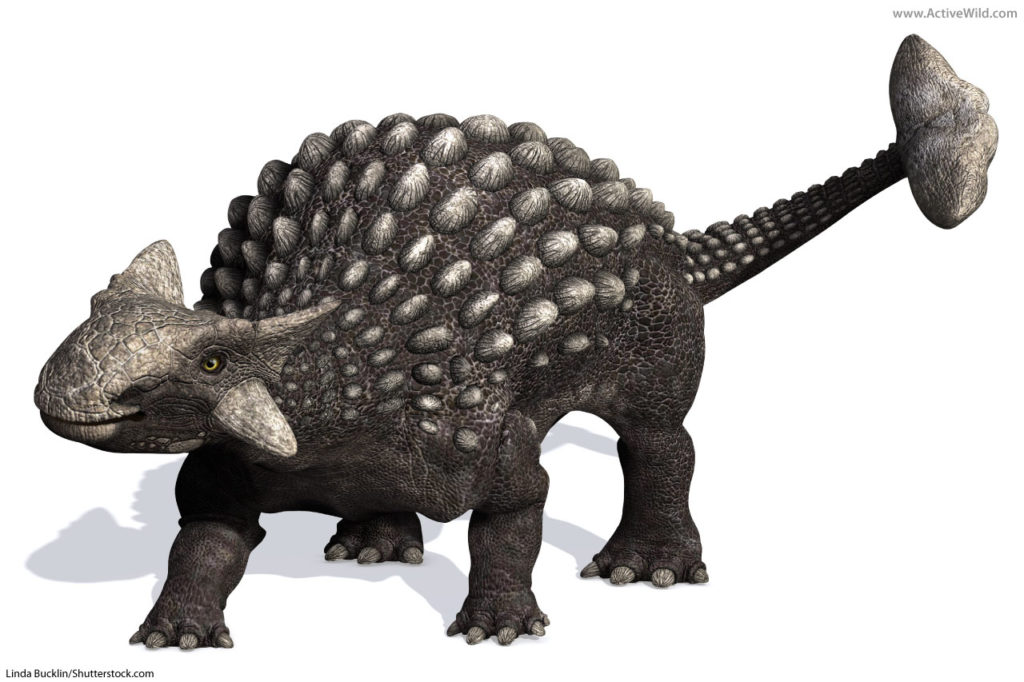
Ankylosauria was a group of armored dinosaurs that appeared in the mid-Jurassic and remained until the end of the Mesozoic era. They were large, powerful, four-legged animals. All were heavily armored, and some developed tail clubs which were likely used as defensive weapons against predators.
Example Ankylosaurians
- Ankylosaurus: The most famous of the ankylosaurians, Ankylosaurus lived during the Late Cretaceous period in North America. It was known for its massive body armor and large club at the end of its tail, used for defense against predators.
- Euoplocephalus: This ankylosaurian lived during the Late Cretaceous in what is now Canada. Euoplocephalus was characterized by its heavy body armor and a small clubbed tail.
- Sauropelta: Living during the Early Cretaceous in North America, Sauropelta was one of the earliest ankylosaurians. It had extensive bony armor along its back but lacked the tail club seen in later species.
- Minmi: Minmi was a small, armored ankylosaurian dinosaur that lived during the Early Cretaceous period in what is now Australia. This relatively small dinosaur reached about 3 meters (10 feet) in length, It had bony body armor and horizontally oriented, bony plates along its sides.
- Nodosaurus: Another early ankylosaurian, Nodosaurus lived in North America during the Late Cretaceous. It was heavily armored but, like Sauropelta, did not have a tail club.
- Polacanthus: This ankylosaurian lived during the Early Cretaceous period in what is now Europe. Polacanthus was known for its distinctive array of spines and armor plates but, similar to earlier ankylosaurians, lacked a tail club.
Ornithopoda
Ornithopods were a branch of Ornithischian dinosaurs that appeared in the mid Jurassic Period and which survived to the end of the Cretaceous Period. They had three-toed feet, beaks, and a relatively advanced mouth structure that enabled them to breathe while chewing.
Family: Hadrosauridae (Duck-Billed Dinosaurs)
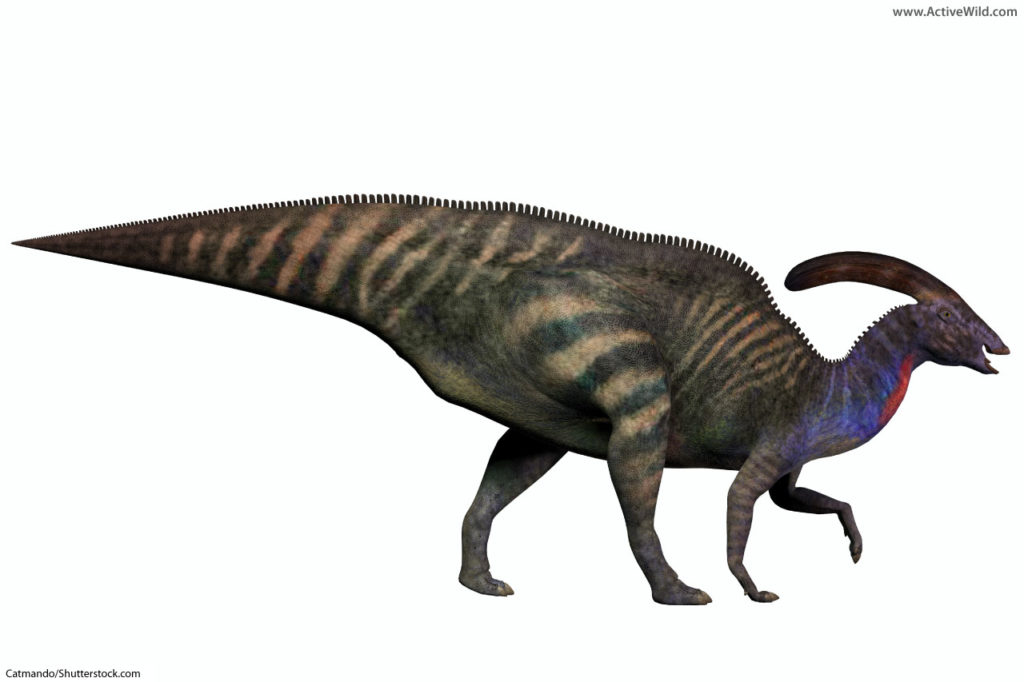
Hadrosauridae was a family of ornithopods descended from the Iguanodontians. Many Hadrosaurids were able to walk both on two and four feet; they likely used all four feet when grazing, but ran using only their hind legs.
Hadrosaurids are also known as "duck-billed" dinosaurs due to their wide mouth parts, which resemble the beaks of ducks. Many hadrosaurids had elaborate cranial crests or ornamentations.
Example Hadrosaurids
- Parasaurolophus: Known for its long, backward-curving cranial crest, which may have been used for communication or display, Parasaurolophus lived during the Late Cretaceous period in North America.
- Edmontosaurus: This large hadrosaurid lacked the fanciful cranial crests seen in some of its relatives. Edmontosaurus, with its broad, duck-like bill, roamed North America during the Late Cretaceous.
- Maiasaura: Meaning "good mother lizard," Maiasaura is famous for evidence suggesting that it cared for its young. It lived during the Late Cretaceous in what is now North America and was crestless like Edmontosaurus.
- Lambeosaurus: This dinosaur is distinguished by its unique hollow cranial crest, which took on various shapes depending on the species. Lambeosaurus lived during the Late Cretaceous period in North America and Asia.
- Corythosaurus: Another crested hadrosaurid, Corythosaurus had a large, helmet-like crest on its head. It lived during the Late Cretaceous in North America and its crest may have been used for vocalization, display, or thermoregulation.
Pachycephalosauria (Marginocephalia)
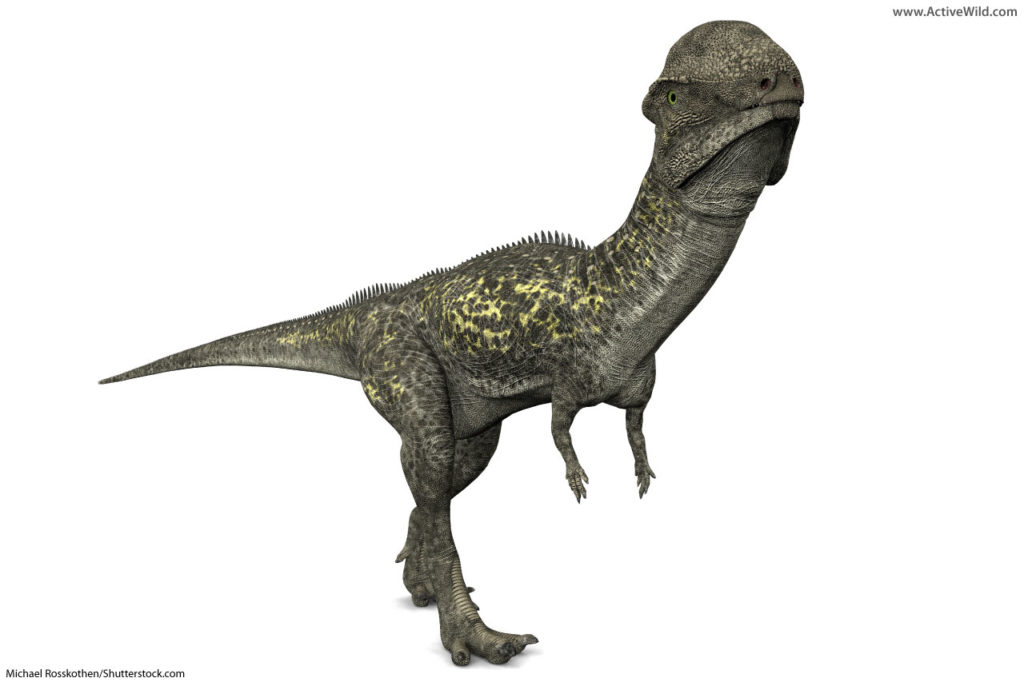
Pachycephalosauria was a type of dinosaur that lived in the Late Cretaceous period. Pachycephalosaurians were bipedal and had thick skulls (the name Pachycephalosauria means ‘thick headed lizards'). Many members of this group had domed skulls, which were often embellished with spikes.
The thick skulls of Pachycephalosaurians may have been an adaptation for fighting. These dinosaurs may have established dominance within their groups by ramming their heads together; a behavior seen in living sheep and goats.
An alternative explanation is that the thicks skulls were used for flank-butting, in which the sides (flanks), rather than the skulls, of rival dinosaurs were targeted.
Example Pachycephalosaurians
- Pachycephalosaurus: The most famous pachycephalosaurian, Pachycephalosaurus lived during the Late Cretaceous period in North America. It had a large, bony dome atop its skull, surrounded by knobs and spikes.
- Stegoceras: Stegoceras was a small pachycephalosaurian dinosaur with a thick, domed skull It lived during the Late Cretaceous period in what is now North America. This bipedal herbivore was around 2 meters (6.5 feet) in length.
- Stygimoloch: Known for its distinctive skull with a smaller dome and a ring of long, horn-like spikes at the back of its head, Stygimoloch also lived during the Late Cretaceous in North America.
- Dracorex: Featuring a unique skull with flat, bony bumps and large spikes, Dracorex, whose name means "dragon king," was a pachycephalosaurian from the Late Cretaceous of North America. Unlike Pachycephalosaurus, Dracorex had a flat skull rather than a domed one.
Ceratopsia (Marginocephalia)
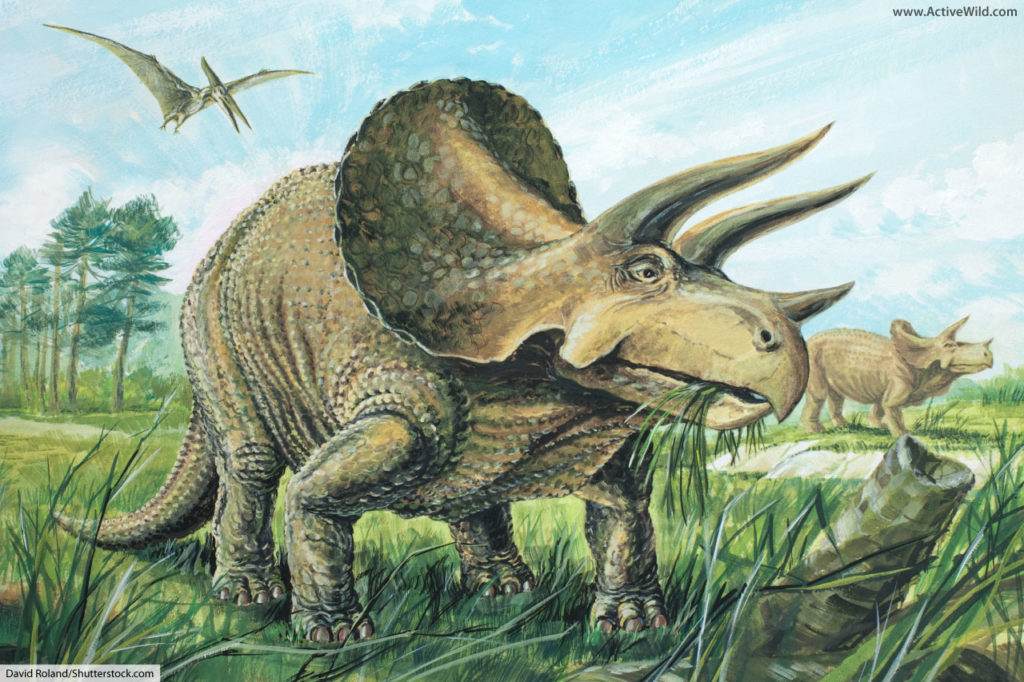
Ceratopsid dinosaurs, known for their prominent frills and facial horns and beak-like mouth parts, were a group of herbivorous dinosaurs that lived primarily during the Late Cretaceous period. The name Ceratopsia means "horned faces".
This group of dinosaurs became common in the Cretaceous period and were found in North America, Europe and Asia. They ranged from 1 - 9 m (3.3 ft to 30 ft.) in length, with the largest weighing around 9 metric tonnes.
Example Ceratopsids
- Triceratops: The most famous ceratopsid, Triceratops is known for its three horns – two over the eyes and one on the nose – and a large bony frill. It lived in what is now North America.
- Styracosaurus: This ceratopsid had a distinctive appearance with a large frill bearing several long spikes, in addition to a single large horn on its nose. Styracosaurus lived in North America during the Late Cretaceous.
- Centrosaurus: Known for its shorter frill with large hornlets at the edges and a single large horn over its nose, Centrosaurus was another North American ceratopsid that lived during the Late Cretaceous.
- Pentaceratops: Sporting five horns and a large, deep frill, Pentaceratops was one of the larger ceratopsids. It lived in North America during the Late Cretaceous period.
- Protoceratops: A smaller and earlier member of the ceratopsid family, Protoceratops lacked the prominent facial horns of its larger relatives but had a well-developed frill. It lived in what is now Mongolia during the Late Cretaceous.
Types Of Dinosaurs: Conclusion
Dinosaurs inhabited Earth for tens of millions of years longer than humans have spent on the planet.
This gave the dinosaurs plenty of time to branch off and evolve into different types of dinosaur.
Dinosaur species had been appearing – and becoming extinct – for millions of years before the mass extinction event at the end of the Cretaceous period that killed off the last non-avian dinosaurs.
After watching films such as Jurassic Park it's easy to forget that not all types of dinosaur lived together. Even dinosaurs that lived in the same period may have been separated by millions of years.
For example, 57 million (or more) years passed between the disappearance of baryonyx walkeri and the appearance tyrannosaurus rex, yet both species lived during the Cretaceous Period.
Like all living animals, dinosaurs can be classified into different groups. However, our entire knowledge of dinosaurs stems from fossilized remains that have been in the ground for an almost unimaginable length of time.
This is why, as we unearth more and more fossils, our understanding of dinosaurs – and the relationship between different types of dinosaurs – is continuously changing.
Discover More With Active Wild
We hope that you have enjoyed learning all about the different types of dinosaur. You can find plenty more dinosaur information on the following pages:
Become a dinosaur expert – check out our main Dinosaur Facts Page.
Learn about the many different dinosaurs of the Mesozoic era: List of Dinosaurs

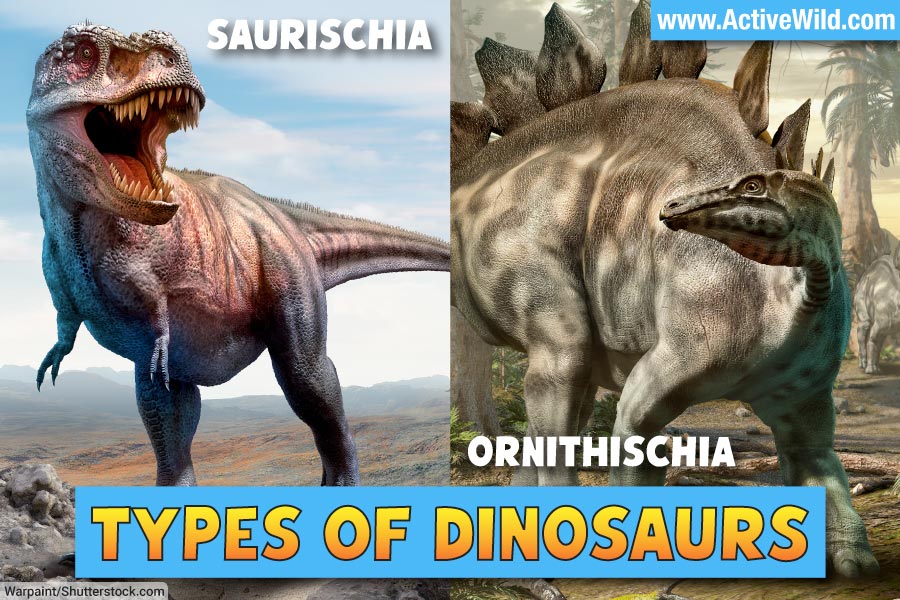

you need more dinosaurs
Hi Nicole,
Check out these pages:
Triassic Dinosaurs
Jurassic Dinosaurs
Cretaceous Dinosaurs
We’re adding more dinos to all of these lists (including this page), so be sure to check back from time to time 🙂
Amazing introduction to taxonomy of dinosaurs! Thank you!
Thank you for your comment, we’re glad you enjoyed it!
i love this website!